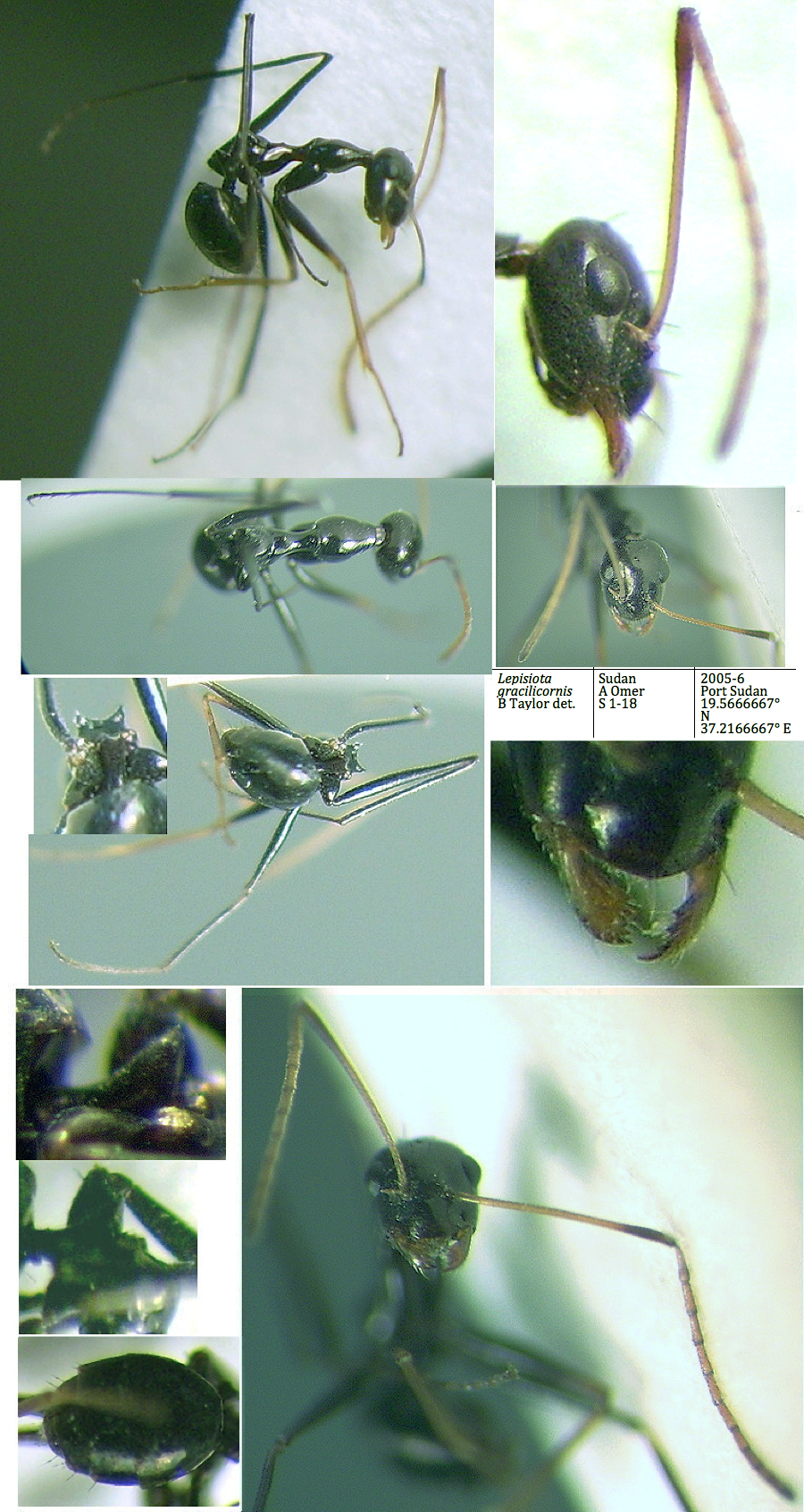Lepisiota omeri Taylor new species
  Type location Sudan,
worker only described Type location Sudan,
worker only described  . .
WORKER
DESCRIPTION: Head in full face view with
sides
forward of the eyes near parallel, clypeus subcarinate, anterior margin
convex, occipitum evenly arcuate; eyes stringly convex, breaking the
outline of the head and set almost entirely behind the mid-point;
median ocellus set well back from posterior level of the eyes; whole
insect elongate, alitrunk particularly long and narrow; propodeum with
acute but broadly based spines; petiole with lateral denticles; almost
without pubescence or erect hairs, except on the front of the head and
posterior segments of the gaster; shiny chestnut brown, head slightly
darker, especially the occiput.
TL ca 3.0 mm, HW 0.6, HL 0.82, CI 82, SL
1.25, SI 220 , PW 0.42 AL 1.3, hind tibia 1.5; EL/HW 0.37
Name in recognition of the collector, Miss Awatif Omer.
Clearly related to Lepisiota
gracilicornis
but that is larger, has a shorter rounder head, proportionally shorter
appendages, smaller eyes, only a weakly shiny appearance and the
colour, although variable, is from brown to near black.
Specimens deposited in the Oxford University Museum of
Natural History.
|
Oxford University Museum
specimens
Lepisiota omeri
B Taylor det.
|
Sudan
A Omer
2009.13
|
2009
Haj Abd Allah
13°58'0"N
33°34'60"E
|
Middle Sudan
|
1
|
 |
Lepisiota omeri
B Taylor det. |
Sudan
Z Mahmoud
2009-31
|
Ad Damazin
11°46'31" N
34°21'10" E
|
Hand collected
|
1
|
 |
Lepisiota omeri
B Taylor det. |
Sudan
Awatif Omer
21
|
2012
Khartoum
15°36.643' N
32°32.500' E
|
|
2
|
 |
|
 The
photomontage is of the holotype worker collected
in Sudan, Haj Abd Allah, Middle Sudan, 13°58'0"N 33°34'60"E, by
Awatif Omer, hand collection, 2009. The
photomontage is of the holotype worker collected
in Sudan, Haj Abd Allah, Middle Sudan, 13°58'0"N 33°34'60"E, by
Awatif Omer, hand collection, 2009.
|
 The
photomontage is of a second worker from Sudan, Ad Damazin,
collector Zuheir
Mahmoud (2009). The
photomontage is of a second worker from Sudan, Ad Damazin,
collector Zuheir
Mahmoud (2009).
|
 The
photomontage is of a third worker collected
in Sudan, Khartoum, by ZAwatif Omer, (2013.21). The
photomontage is of a third worker collected
in Sudan, Khartoum, by ZAwatif Omer, (2013.21).
|
| Lepisota omeri n sp Sudan |
Lepisiota
gracilicornis |
Lepisiota
aegyptiaca |
| Base colour chestnut brown;
appendages paler, occiput darker |
Base colour brown-black; antenna and
tarsi/tibiae orange-brown; anterior of head and mandibles also paler to
orange |
Base colour dark chestnut, lighter
on pronotum and head, antennae and tibiae/tarsi yellow-brown |
| TL ca 3.0 mm; HW 0.6 HL 0.82 PW 0.42
AL 1.3 Hind tibia 1.5; CI 82 SI 192 EL/HW 0.37 PW/AL 0.32 |
TL ca 3.7 mm (range 2.5-5); HW 0.7
HL 0.7 PW 0.5 AL 1.5 Hind tibia 1.6; CI 85 SI 194-200 EL/HW 0.32 |
TL ca 3.2 mm (type 2.3 mm?); HW 0.58
HL 0.7 PW 0.53 AL 1.2 Hind tibia 1.2; CI 80 SI 173 EL/HW 0.33 |
| Median ocellus set well back from
posterior level of the eyes |
Median ocellus set at about the
posterior level of the eyes |
Median ocellus set well back from
posterior level of the eyes |
| Propodeal spines quite long and
apically narrowed, petiole with apex concave and sharp laterally not
developed into distinct teeth |
Propodeal spines quite long, petiole
with moderate apical teeth |
Propodeal spines realtively short,
petiole without apical teeth |
| Tibiae distinctly longer than
alitrunk |
Tibiae slightly longer than the
alitrunk |
Tibiae about the same length as the
alitrunk |
| Scape with slight apical broadening;
head almost without pubescence |
Scape distinctly broadening in
apical fifth; head with quite abundant short pubescence |
Scape weakly broadening in apical
quarter; head with sparse short pubescence |
| Overall vary shiny, head slightly
dull |
Relatively dull due to very fine
reticulate sculpturation |
Shiny with polished areas |
|
 The photomontage is
of specimens of Lepisiota
gracilicornis collected in Sudan, at Port Sudan, Sudan
1.18, by Awatif Omer, 2005. The photomontage is
of specimens of Lepisiota
gracilicornis collected in Sudan, at Port Sudan, Sudan
1.18, by Awatif Omer, 2005.
|
 The photomontage is
of specimens of Lepisiota
aegyptiaca from Egypt, Sinai, Nakeb, 13.iii.1982, collector J
Kugler; sent to BT by Armin Ionescu, Tel Aviv University. The gaster is
fully shiny, the specimen shown has a small amount of glue on the first
tergite. The photomontage is
of specimens of Lepisiota
aegyptiaca from Egypt, Sinai, Nakeb, 13.iii.1982, collector J
Kugler; sent to BT by Armin Ionescu, Tel Aviv University. The gaster is
fully shiny, the specimen shown has a small amount of glue on the first
tergite.
|
|